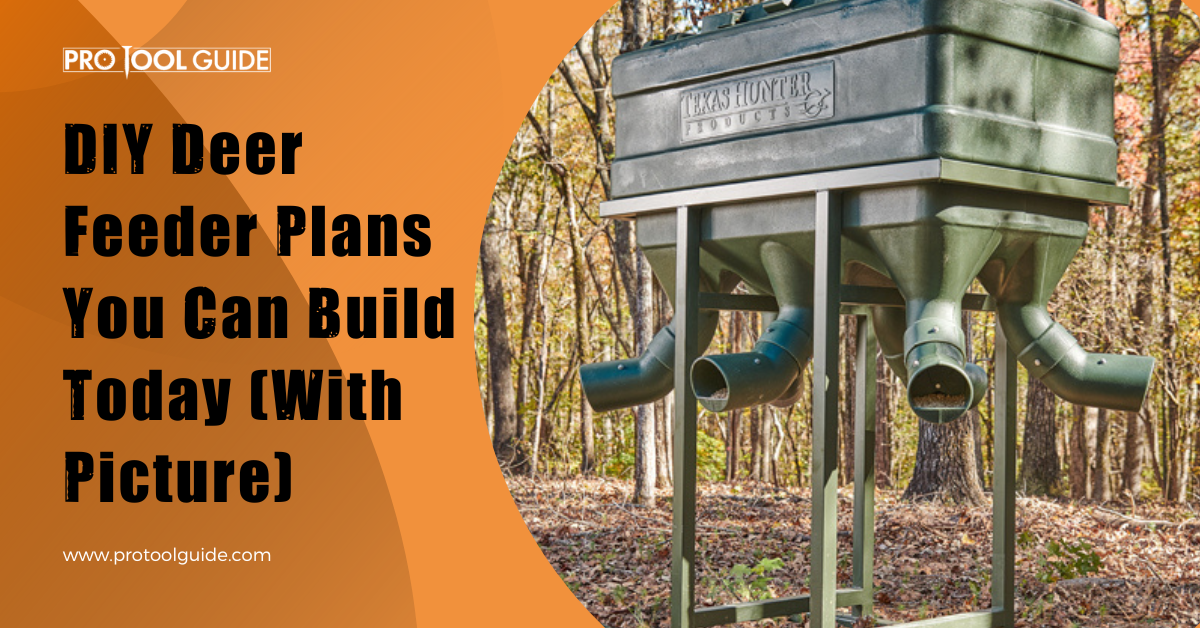If you love watching deer up close, you’re in luck, as deer are creatures of habit and would keep returning to a location where they get good treats. Setting up a feeder and keeping it going with feed will attract deer and similar animals to your field.
Buying commercial feeders for the deer can be expensive, which is why the more affordable DIY options are in high demand. However, few people know how this project should be completed, so we’ve set up this guide to provide several deer feeder designs and plans.
These plans are easy to build and typically take a few hours to complete. The deer feeder is also vital for hunters to attract the deer into an open field where it is easier to hunt. Your hunting season will thank you for investing in building a deer feeder.
DIY Deer Feeder Plans
Whether you’re a deer lover or a hunter, a deer feeder will bring deer to you, and building this feeder is often the more affordable option. You can save money while enjoying building this simple project. Find out all the plans for a deer feeder here:
1. Homemade Deer Feeder From PVC Pipes
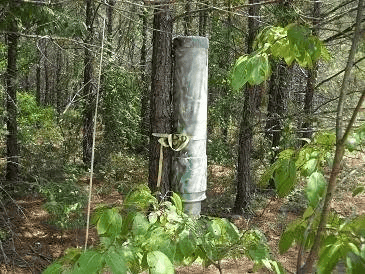
PVC pipes and the right accessories can make an effective deer feeder, with a single 10-foot pipe able to build two deer feeders. This plan utilizes a 6-inch diameter PVC pipe to get a large feeder that can hold a lot of deer feed. This means you don’t have to frequently use the spot for refilling, which is often the leading cause of spooking deer around feeders.
The budget-friendly project requires little to no maintenance and can last up to fifteen years, making it a durable and practical feeder. You’ll need the PVC, glue, paint, straps, and fittings to build this gravity feeder where the feed keeps flowing downwards.
The fittings for this project include PVC couplings, PVC reducers, and PVC caps, all in the correct dimensions. You’ll need to divide the 10-foot PVC pipe into two parts, with one part being enough for the project. The guide contains all the steps to completing this deer feeder.
2. DIY Deer Feed Trough Plan
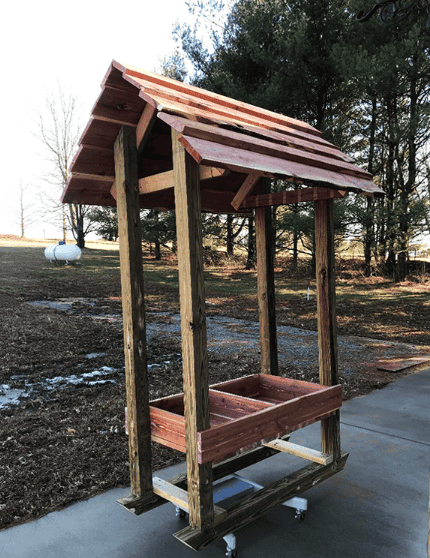
Building designs like this deer feed trough is exciting and fulfilling, with its structure similar to the top of a wishing well. It features two open feed sections protected with a hip roof and elongated support. The fixture is not fixed to the ground, so it is easy to move; however, this will also make it easy for strong winds to blow it away.
The stylish roof is made of wood arranged in a pattern that makes it easy for water to run off quickly. The comprehensive feed makes it possible to feed several deers simultaneously while providing a conducive environment. A DIY enthusiast with medium-level experience can handle this project in a single weekend.
You’ll need several pieces of 4×4 lumber, 2×6 lumber, 2×2 lumber, ¾” plywood, 1×6 for roofing, rafters, 2×4 lumber, and other accessories like nails, screws, and paint. Start by building the legs and the feed trough before moving on to the support beams and roof.
3. Large Trough-Style Feeder
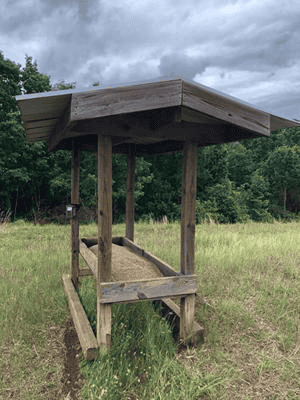
You need a large deer feeder like the one in this design to attract many deers to your field. This covered trough-style feeder design is low-maintenance as it does not feature motors or complex moving parts. All deer sizes can access the trough with the correct measurements without struggling.
You can get up to fifteen years off the feeder with treated lumber. The legs are built to form skids, so moving the feeder to a different location is more effortless. Attach a chain with lag bolts to the 4×6″ ends to hook up your trailer and drag it to a different location. You’ll find the complete list of materials inside the guide.
Ensure the roof is high enough so the deer get enough room to access the feeder. The idea is simple but effective, offering visibility as the deer eats. The large feed area will carry a good amount of feed.
4. Barrels Deer Feeder
Barrels are excellent materials to build the perfect deer feeder with this plan using a 55-gallon feed tube. This gravity deer feeder sends feed down to the nozzle, where the deer can eat. The feed in the nozzle will be replenished automatically when the nozzle is depleted, as long as the feed tube is not empty.
The barrel can be made of metal or plastic; however, ensure it comes with a lid to close the tube after refilling to prevent birds and moisture from damaging it. You can get these barrels from local farms or car dealerships for free, significantly reducing the project’s overall cost.
Attach a feed tube with three feeding ports to the barrel to channel feed closer to the deer. The setup features an adjustable controller inside the feed tube that allows you to regulate the amount of feed you want to enter the feeding ports. This plan uses long tripod stands to hold this barrel above the ground.
5. 5 Gallon Bucket Deer Feeder

You can make an easy deer feeder project with an easy-to-get five-gallon bucket. All you need is an excellent five-gallon bucket with a lid, a utility knife, a drill, a curved PVC corner pipe, a screwdriver, a screw dowel rod, and a binder rope. With these materials, you can complete the feeder in under two hours.
Start by cutting the correct hole size under the bucket. Measure the size of the PVC and cut it out from under the bucket while ensuring you make the hole as small as possible. You can use the dowel rod and screw approach or connect the PVC pipe where the feed falls into the pipe for the deer to eat.
Hanging the bucket from a tree branch is the easiest option; however, depending on the size of the branch, the bucket may be too heavy for it. You may have to install a dedicated stand to raise the bucket away from the ground.
6. Deer Box Feeder
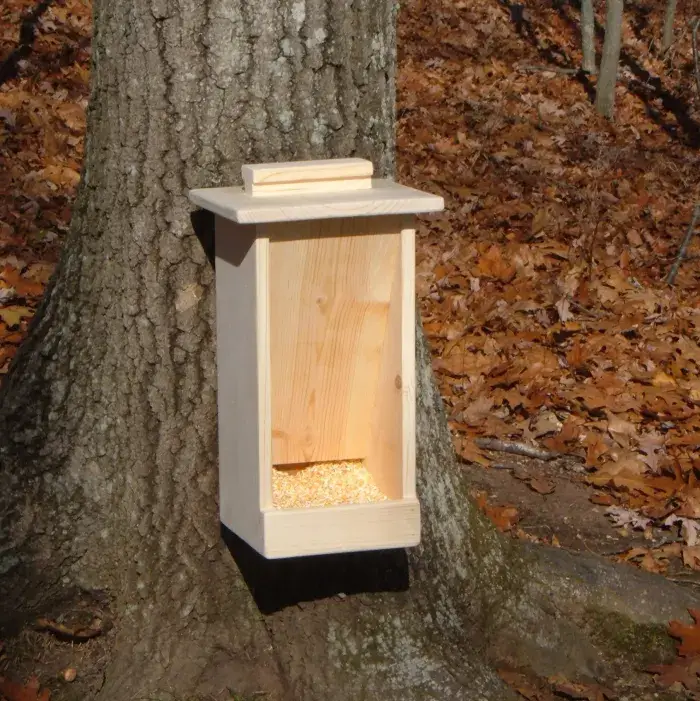
Here is a small box feeder made from pine or cedar with a simple mechanism where feed falls from the holder on top. The feed enters the trough, which is easier to access by deer and even turkeys. It works when you add the feed to the top chamber and close the lid while slowly entering the animal tray.
The building process is divided into smaller parts to make it easier for intermediate-level DIYers to follow. Each section needs specific wood sizes, which are provided in the complete plan for this design. Assembling the boards becomes easy when you’ve made the right cuts.
Choose the correct position and height to hang the feeder so deer can easily see and reach the tray. The side of a tree is an ideal location to secure this box feeder. Remember that this box of feed will attract more than one deer.
7. Hanging Bucket Feeder
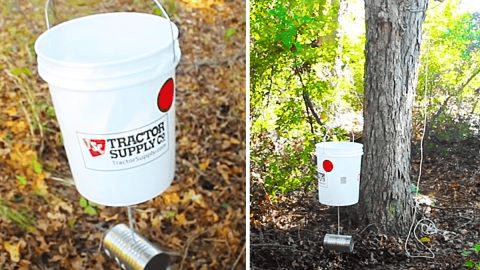
A simple five-gallon bucket combines with an even more straightforward process to create this feeder for deer. All you need is a bucket, a strong rope, a metal can, washers, and a rod. The idea is to cut a small portion from under the bucket and connect a rod attached to a metal can.
When a deer moves the metal container, it shifts the washer, closing the hole and allowing feed to fall to the ground. Ensure to use a shiny metal that will easily attract the attention of the deer.
You need to attach a piece of wood to the bucket, which holds the metallic can underneath and prevents the feed from falling off. Hang the bucket using the durable rope over a strong tree branch, or use a stand to hang it.
8. Camouflaged Drum Feeder
Camouflaged feeding materials hide the setup and make it look so natural that even the most cynical deer will feel comfortable around it. It is a 55-gallon used to build a deer feeder with sections cut out below so the feed can fall off when the deer nudges it. You can build multiple pieces since the project is easily accomplished with suitable materials.
A funnel-like material is added to the drum to make it easier for the feed to come out through the openings below. With some board pieces on the ground in front of all the cuts to catch the feed as it comes out. The funnel inside the drum will make the feed slope outward through those cut parts.
The plan offers information on how to build this feeder, camouflage it, and even secure it to prevent it from being knocked to the ground. The rubber lid is cut off and replaced with a more secure aluminum lid.
9. DIY Drum Feeder with Four Legs
55-gallon drums are massive and durable, so they are popular when building deer feeders. This design is fitted with two PVC pipes acting as the transport and feed trays. The drum and pipes are camouflaged, making them harder to spot and preventing the spooking of even the most mature deer.
The plastic system makes this design unique, with its durable four legs providing stability. You don’t have to hang on a tree or platform with less balance, as the plan features strong lumber holding the drum in place.
You can place a mat around the area and adjust the process so the feed goes all the way through the pipe to the mat. Due to the style of the lid, you need to cut it off and replace it with a suitable cover where it is easy to refill the drum’s contents.
FAQ’s
We understand that questions about the best deer feeder plan to build may arise, so we’ve included this section to answer some of the most popular questions.
Ans. In some regions, it is illegal to feed deer using feeders, as this may spread diseases when the deer congregate. It is advisable to seek clearance to ensure your region is not under such regulations.
Ans. Some regions do not permit hunting deer from deer feeders, so if that is your aim of setting up a deer feeder, you’ll be better off seeking clearance first.
Ans. The best location is where it is visible to the deer and you, so the deer can see the feeder while you can also spot the deer when feeding.
Summary
Before you proceed with your plan of building a deer feeder, confirm with the authorities in charge about the legality of using a feeder for deer or hunting deer over a feeder. Select any of the numerous deer feeder plans in this guide.
